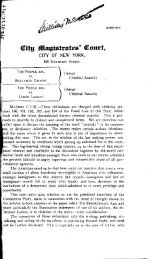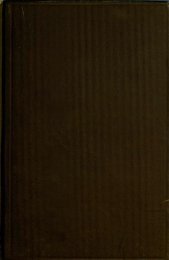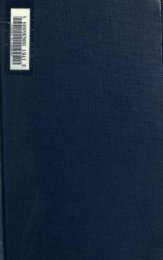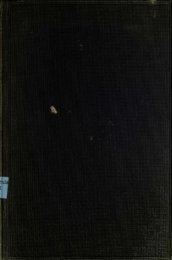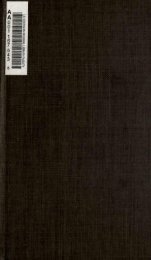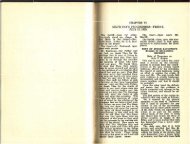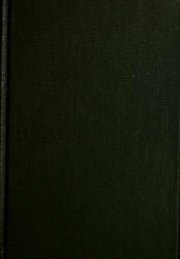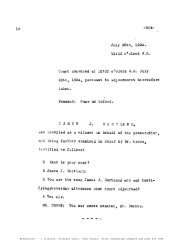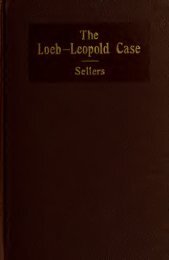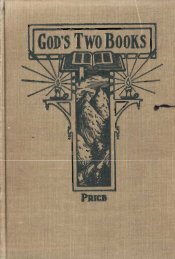The Chicago Martyrs by John P. Altgeld
The Chicago Martyrs by John P. Altgeld
The Chicago Martyrs by John P. Altgeld
You also want an ePaper? Increase the reach of your titles
YUMPU automatically turns print PDFs into web optimized ePapers that Google loves.
100<br />
ADDRESS OF ALBERT R.<br />
PARSONS.<br />
ADDRESS OF ALBERT R. PARSONS.<br />
101<br />
not tall in height, exactly corresponds with Burnett's description of the man<br />
he saw, both light and hurl the bomb, and Burnett stood here. You remember<br />
it; Burnett was standing right abOut here when he testified; he said that<br />
he was standing <strong>by</strong> the side of the man and saw the man light the bomb, and<br />
hurl it in that direction. It tallies with the man sW9rn to here <strong>by</strong> <strong>John</strong> Philip<br />
DeLuce, the man called for <strong>by</strong> the New York Times, Herald and T1'ibtme, <strong>by</strong><br />
implication at least, that this thing must be stopped. Pinkerton comes out<br />
in a circular and offers to do this kind of work. It is the hand of the police.<br />
Now, is it anything beyond human reason that tbese·men could not carry out<br />
that which they said they were ready to do-to do that which they themselves<br />
claimed it would be worth to them millions to do? I am not putting statements<br />
in their mouths. <strong>The</strong>y stated here that they were ready to do such<br />
work; perhaps they may have overdone the work; perhaps they killed more<br />
men than they intended to kill; perhaps that may be true. Perhaps they did<br />
not intend that it should be so great a sacrifice as it was; but I will continue<br />
with reference to this; Burnett's pescription of the identical man he saw<br />
both light and hurl the bomb thirty, five feet south of the alley, show that the<br />
prediction of the stranger from <strong>Chicago</strong>, "You will hear from it," was veri.<br />
fied within twenty-four hours, because it was not a dynamite, but an infernal<br />
bomb, of ,,"hich this stranger boasted in his cups when pointing to the satchel<br />
and sayi~g, "I have something in here that will work; you will hear of It;<br />
you will shortly hear of trouble in <strong>Chicago</strong>," speaking of the pending troubles<br />
in this city.<br />
Within twenty-four hours after this incident at Indianapolis, as sworn to<br />
before this court, the something in that satchel was heard from, and its detonation<br />
is still ringing in the ears of a startled world. <strong>The</strong> day following, the<br />
5th of May, the Daily News of <strong>Chicago</strong> published the first description in<br />
print of the man who threw the bomb, from one who swore he was neither' a<br />
Socialist, an Anarchist, nor a COplmunist, but a mere idle and curious specta.<br />
tor at the meeting. <strong>The</strong> News said on May 5: ,. <strong>The</strong> police have a good<br />
description of the man who threw the bomb at the Anarchists' meeting lsst<br />
night. <strong>The</strong> fellow stood in front of <strong>John</strong> Burnett, a candy maker in the employ<br />
of Mr. Berry, at the corner of Washington and Sangamon streets, and<br />
was seen <strong>by</strong> him to throw the missile of death. <strong>The</strong> atrocious murderer was<br />
a young man, a little above medium height, and well dressed. He was seen<br />
to take the bomb frum his pocket and light it just as the police drew near.<br />
Burnett said he stood within two feet of the man, and would certainly be able<br />
to i'dentify him SHould he meet hi1TI again. Hardly a moment elapsed after<br />
the bomb was light(d nntil tbe man lifted his arm preparatory to casting it<br />
from him. Every detail of this performance was witnessed <strong>by</strong> Burnett, who<br />
did not know what to make of this strange action. Presently the fuse attached<br />
to the bomb commenced to burn, and then, for the first time, Burnett r.ealized<br />
what was about to happen. <strong>The</strong> man, with a quick jerk of his arm, sent the<br />
bomb flying through the air, and the next instant turned to run. Burnett<br />
attempted to follow, but a stray buUet struck him in the arm and he fell to<br />
the sidewalk. When he got up all was confusion. <strong>The</strong> foregoing is the suh.<br />
stance of the story told the reporter this morning. Detectives were sent out<br />
to hunt for Burnett, but they were nnable to find him."<br />
Your honor, this was the fifth day of May, the day following the Haymarket<br />
affair. Mr. Burnett was found and repeated the above facts to the<br />
district attorney. reaffirming the statement to which he subsequently swore<br />
n court for the defense, that the strange 'man stood t.hirty-five feet south of<br />
the alley; that he saw him light the fuse and then throw tbe bomb; that he<br />
'Wore dark clothes; and it was proven on trial that Rudolph Schnaubelt, the<br />
man Giimer implicated, wore light· clothes that night, and tbis Pinkerton<br />
man had a mustache and no chin or side whiskers, while Schnaubelt, the<br />
Anarchiet, had hoth; and he was a man of medium size, whereas Schnaubelt<br />
is noted for his great height; be is six feet two inches. <strong>The</strong> district attorney<br />
had to stultify his own witnesses <strong>by</strong> tbe unsupported, manufactured, perjured<br />
evidence of Gilmer, because for forty piecps of silver, he was willing to swear<br />
that Spies lit the fuse while another man threw the bomb-a very tall man in<br />
height, in light clothes, with a light or sandy beard. Gilmer swore that when<br />
Fielden was speaking he was looking for a party be expected to find there,<br />
"and I went back in the alley between the Crane building ~nd tbe building<br />
on the south of it. I stopped in the alley and noticed some parties in conversation<br />
across the alley on the soutb side. Some one said: 'Here come the<br />
police.' <strong>The</strong>re was a man who jumped from the wagon down to the parties<br />
somewhere standing on the south side of the alley, and lit a match and touched<br />
off something or other, and the man gave a couple of steps forward and<br />
tossed it over into the street."· Side <strong>by</strong> side with this, ,,"e ~ive the preci~e<br />
words of Mr. Bonfield, as published in the Cbicago Times of May 5, to a knot·<br />
of reporters gathered around him at the station house half an hour after the<br />
tragedy occurred. He is reported in the Times of May 5 to have said: "<strong>The</strong><br />
exact scene of ihe explosion is near the centerof the street and exactly opposite<br />
the alley on the east side which separates No.9 South Desplaines street<br />
from Crane Brothers' foundry. At intervals between this alley and Randolph<br />
street there are large, heavy, box-like frames at the edge of the sidewalk, and<br />
it is here that the bomb was thrown." Lieutenant Haas located the spot<br />
there also as some fifteen feet south of the alley, not in the alley, as Gilmer<br />
would have it. Yes, the prediction of the Indianapolis stranger was verified.<br />
<strong>The</strong> bomb was heard from, and heard around the world. <strong>The</strong> purpose avowed<br />
in the New York city papers to pick out the leaders and make such examples<br />
of them as to scare the others into submission, was put into successful execution,<br />
and well was the diabolical and nefarious plot executed. Eight men<br />
" leaders "-tbree labor editor~ and five labor organizers and orators-now<br />
II fore you, are here to receive sentence of death in pursuance of that vile plot,<br />
01 which the Haymarket tragedy, in the hands of a Pinkerton detective, was<br />
til ntering wedge; and Gilmer's testimony is but a part of a scheme to<br />
tHvMt .\ttention from the evidence of twelve witnesses, exclusive of Bonfield's,<br />
to til 'I"i'lll(',~ reporter, that the infernal machine was hurled from fifteen to<br />
Uill'fy·/lvu f elL south of the alley, just where the short man in dark clothes<br />
I\lltlllllly Mtoo(l wh(lIl the angel of death was sped on its infernal mission, not<br />
mil to Muc"llkll JlIII'JlllHOly the lives of the policemen on the ground, but that<br />
11111 I, hOI' I, "d,,,'/\ IlIil(hl, ho arrested and doomed to death under a charge of<br />
till ,'011111. lOll.,! 1111 om'"f1', in order, as avowed <strong>by</strong> the New YOlk Times,<br />
1111 'I 1ol1111 I. IIlId ",,,,,,, 41111,,\1 lI'u of thtl fallil1R stock markets of the east, to scare




